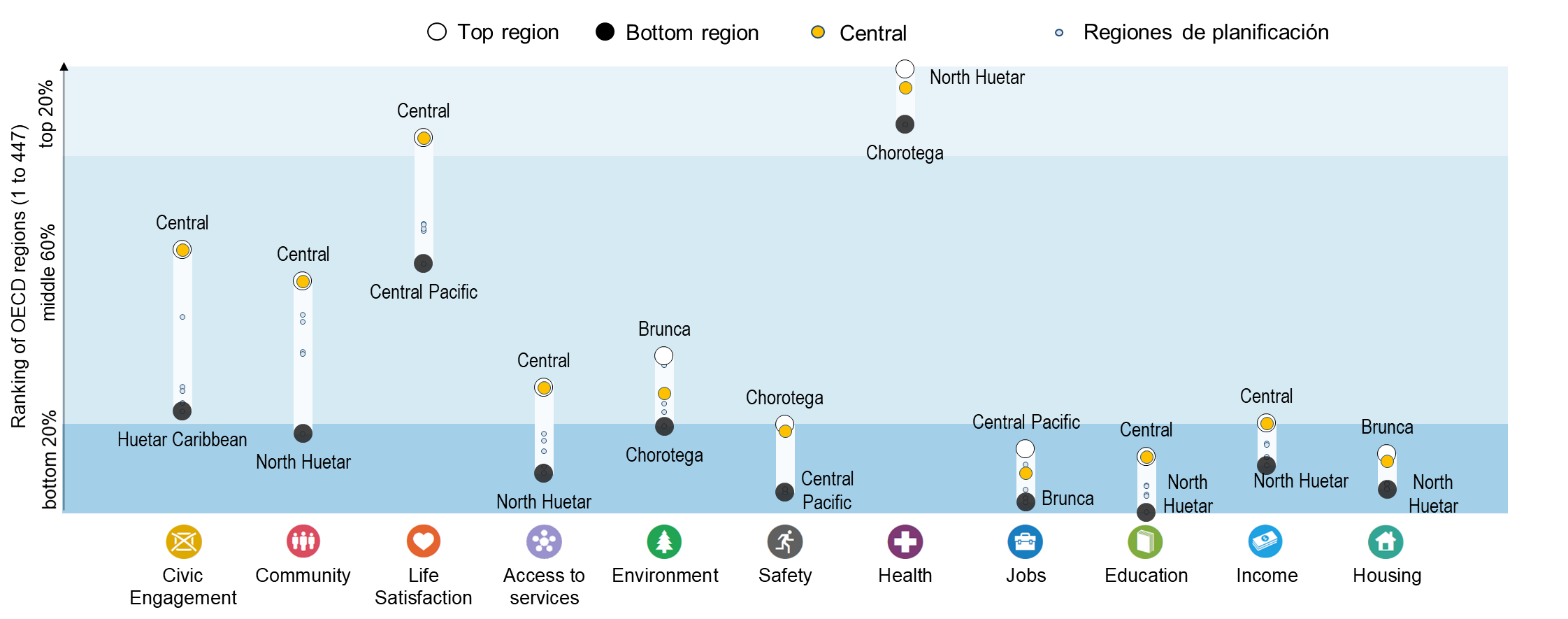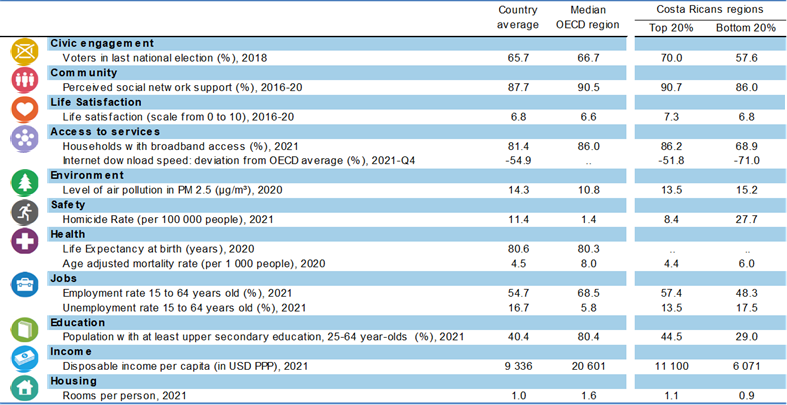Costa Rica
The data in this note reflect different sub-national geographic levels in OECD countries:
Regions are classified on two territorial levels reflecting the administrative organisation of countries: large regions (TL2) and small regions (TL3). Small regions are classified according to their access to metropolitan areas (Fadic et al. 2019).
Functional urban areas consist of cities – defined as densely populated local units with at least 50 000 inhabitants – and adjacent local units connected to the city (commuting zones) in terms of commuting flows (Dijkstra, Poelman, and Veneri 2019). Metropolitan areas refer to functional urban areas above 250 000 inhabitants.
In addition, some indicators use the degree of urbanisation classification (OECD et al. 2021), which defines three types of areas:
- Cities consist of contiguous grid cells that have a density of at least 1 500 inhabitants per km2 or are at least 50% built up, with a population of at least 50 000.
- Towns and semi-dense areas consist of contiguous grid cells with a density of at least 300 inhabitants per km2 and are at least 3% built up, with a total population of at least 5 000.
- Rural areas are cells that do not belong to a city or a town and semi-dense area. Most of these have a density below 300 inhabitants per km2.
Disclaimer: https://oecdcode.org/disclaimers/territories.html
Regional economic trends
Employment and unemployment rates in regions
In Costa Rica, regional disparities in unemployment rates are moderate compared to other OECD countries. While in Chorotega 12.4% of the working force was unemployed in 2022Q2, the share was 10.9% in Brunca.
Meanwhile, the difference in employment rate between the regions with the highest (Central) and lowest (Brunca) employment rates reached 10 percentage points in 2022.
Note: Harmonised employment and unemployment rates, aged 15 and over. The OECD median corresponds to the median employment rate in large regions.
Source: OECD (2022), “Short-term regional statistics”, OECD Regional Statistics (database)
Well-being, liveability and inclusion in regions
Regional well-being
Costa Rica faces stark regional disparities across three well-being dimensions, with the starkest disparities in terms of civic engagement, community and life satisfaction.

Note: Regional indices provide a first comparative glance of well-being in OECD regions. The figure shows the relative ranking of the regions with the best and worst outcomes in the eleven well-being dimensions, relative to all OECD regions. The eleven dimensions are ordered by decreasing regional disparities in the country. Each well-being dimension is measured by the indicators in the table below.
Relative to other OECD regions, Costa Rica performs best in the health dimension, with all of Costa Rican regions lying in the top 20% of OECD regions.
The top 20% of Costa Rican regions rank above the OECD median region in 5 out of 14 well-being indicators, performing best in terms of life satisfaction and voter turnout in the last national election (prior to 2022).

Note: Regional well-being indices are affected by the availability and comparability of regional data across OECD countries. The indicators used to create the indices can therefore vary across OECD publications as new information becomes available. For more visuals, visit https://www.oecdregionalwellbeing.org.
The digital divide
Fixed Internet connections in Costa Rican cities and rural areas deliver speeds significantly slower than the OECD average (-56% and -74%, respectively). This gap (18 percentage points) is smaller than in most other OECD countries.
Note: Cities and rural areas are identified according to the degree of urbanisation (OECD et al. 2021). Internet speed measurements are based on speed tests performed by users around the globe via the Ookla Speedtest platform. As such, data may be subject to testing biases (e.g. fast connections being tested more frequently), or to strategic testing by ISPs in specific markets to boost averages. For a more comprehensive picture of Internet quality and connectivity across places, see OECD (2022), “Broadband networks of the future”.
Source: OECD calculations based on Speedtest by Ookla Global Fixed and Mobile Network Performance Maps for 2020Q4.
The average speed of fixed Internet connections is below the OECD average in all Costa Rican regions. Within the country, residents of Central, Chorotega and Central Pacific experience the fastest connections.
Demographic trends in regions and cities
Dependency rate
The elderly dependency rate1 in Costa Rica is also lower than the OECD average (26.8 %) in all regions, ranging from 14.3% in Central to 9.9% in North Huetar.
Environmental challenges in regions and cities
Greenhouse gas emissions in regions
Since 1990, production-based greenhouse gas emissions have increased in all Costa Rican regions. Central (95%) and Huetar Caribbean (23%) experienced the largest and lowest increase in emissions, respectively.
Note: Bubbles are proportional to per capita greenhouse gas emissions, not to the overall level of greenhouse gas emissions in the region.
Source: OECD calculations, based on the Emissions Database for Global Atmospheric Research (European Commission. Joint Research Centre. 2019).
In 2018, greenhouse gas emissions per capita in Costa Rica were largest in Chorotega, Central Pacific and North Huetar. Agriculture accounts for the largest share of greenhouse gas emissions in North Huetar, while the transport sector accounts for most emissions in Chorotega and Central Pacific.
Note: Regions with low population counts may rank high in greenhouse gas emissions per capita while contributing relatively little to overall emissions in the country.
References
Source of administrative boundaries: © OECD, © EuroGeographics, National Statistical Offices, © UN-FAO Global Administrative Unit Layers (GAUL)
Footnotes
The elderly dependency rate compares the number of elderly people at an age when they are generally economically inactive (i.e. aged 65 and over), to the number of people of working age (i.e. 15-64 years old).↩︎
